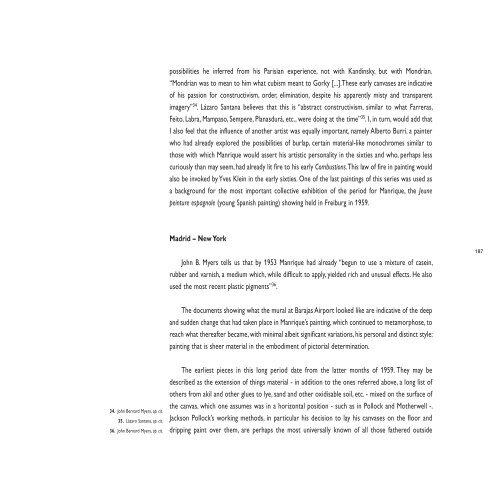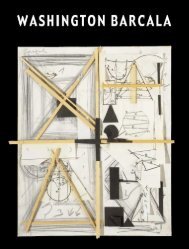VERSIÓN INGLESA ENGLISH VERSION - Fundación César Manrique
VERSIÓN INGLESA ENGLISH VERSION - Fundación César Manrique
VERSIÓN INGLESA ENGLISH VERSION - Fundación César Manrique
You also want an ePaper? Increase the reach of your titles
YUMPU automatically turns print PDFs into web optimized ePapers that Google loves.
34. John Bernard Myers, op. cit.<br />
35. Lázaro Santana, op. cit.<br />
36. John Bernard Myers, op. cit.<br />
possibilities he inferred from his Parisian experience, not with Kandinsky, but with Mondrian.<br />
“Mondrian was to mean to him what cubism meant to Gorky [...].These early canvases are indicative<br />
of his passion for constructivism, order, elimination, despite his apparently misty and transparent<br />
imagery” 34 . Lázaro Santana believes that this is “abstract constructivism, similar to what Farreras,<br />
Feito, Labra, Mampaso, Sempere, Planasdurá, etc., were doing at the time” 35 . I, in turn, would add that<br />
I also feel that the influence of another artist was equally important, namely Alberto Burri, a painter<br />
who had already explored the possibilities of burlap, certain material-like monochromes similar to<br />
those with which <strong>Manrique</strong> would assert his artistic personality in the sixties and who, perhaps less<br />
curiously than may seem, had already lit fire to his early Combustions. This law of fire in painting would<br />
also be invoked by Yves Klein in the early sixties. One of the last paintings of this series was used as<br />
a background for the most important collective exhibition of the period for <strong>Manrique</strong>, the Jeune<br />
peinture espagnole (young Spanish painting) showing held in Freiburg in 1959.<br />
Madrid – New York<br />
John B. Myers tells us that by 1953 <strong>Manrique</strong> had already “begun to use a mixture of casein,<br />
rubber and varnish, a medium which, while difficult to apply, yielded rich and unusual effects. He also<br />
used the most recent plastic pigments” 36 .<br />
The documents showing what the mural at Barajas Airport looked like are indicative of the deep<br />
and sudden change that had taken place in <strong>Manrique</strong>’s painting, which continued to metamorphose, to<br />
reach what thereafter became, with minimal albeit significant variations, his personal and distinct style:<br />
painting that is sheer material in the embodiment of pictorial determination.<br />
The earliest pieces in this long period date from the latter months of 1959. They may be<br />
described as the extension of things material - in addition to the ones referred above, a long list of<br />
others from akil and other glues to lye, sand and other oxidisable soil, etc. - mixed on the surface of<br />
the canvas, which one assumes was in a horizontal position - such as in Pollock and Motherwell -.<br />
Jackson Pollock’s working methods, in particular his decision to lay his canvases on the floor and<br />
dripping paint over them, are perhaps the most universally known of all those fathered outside<br />
187
















![Becas y premios de la Fundación César Manrique [1997-2006]](https://img.yumpu.com/20766851/1/184x260/becas-y-premios-de-la-fundacion-cesar-manrique-1997-2006.jpg?quality=85)
